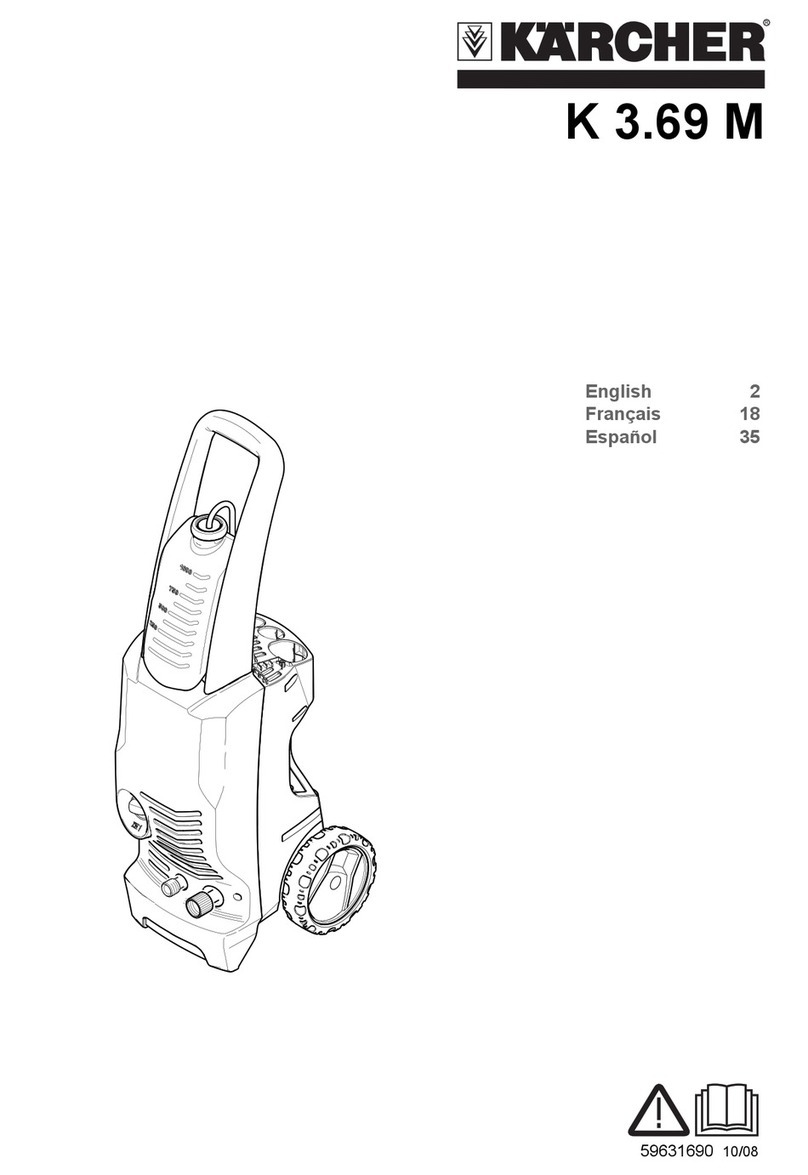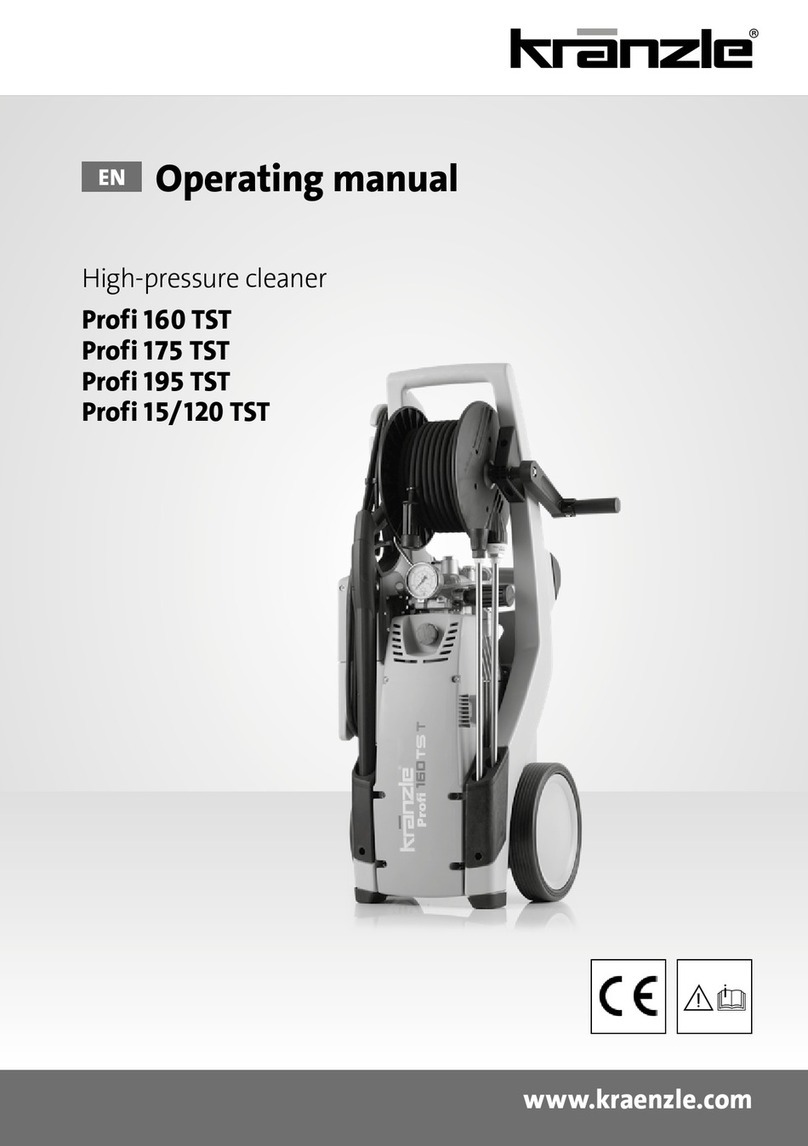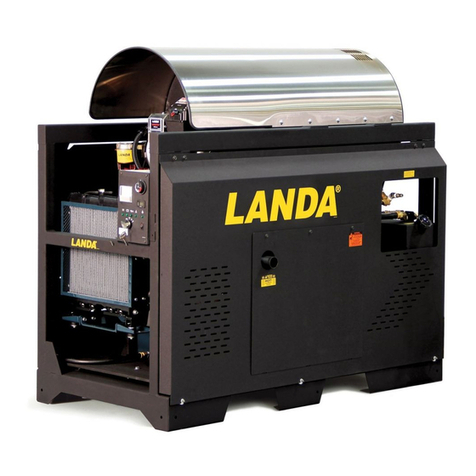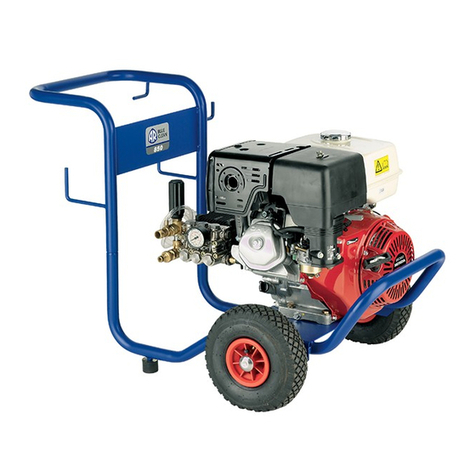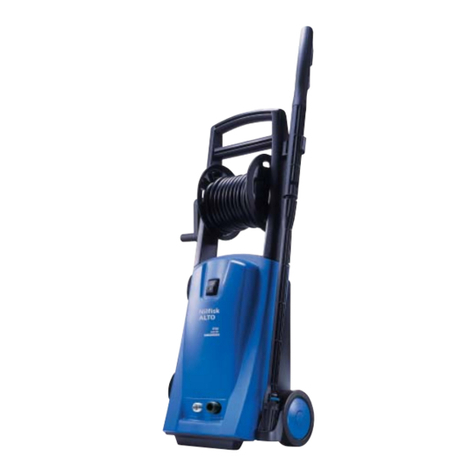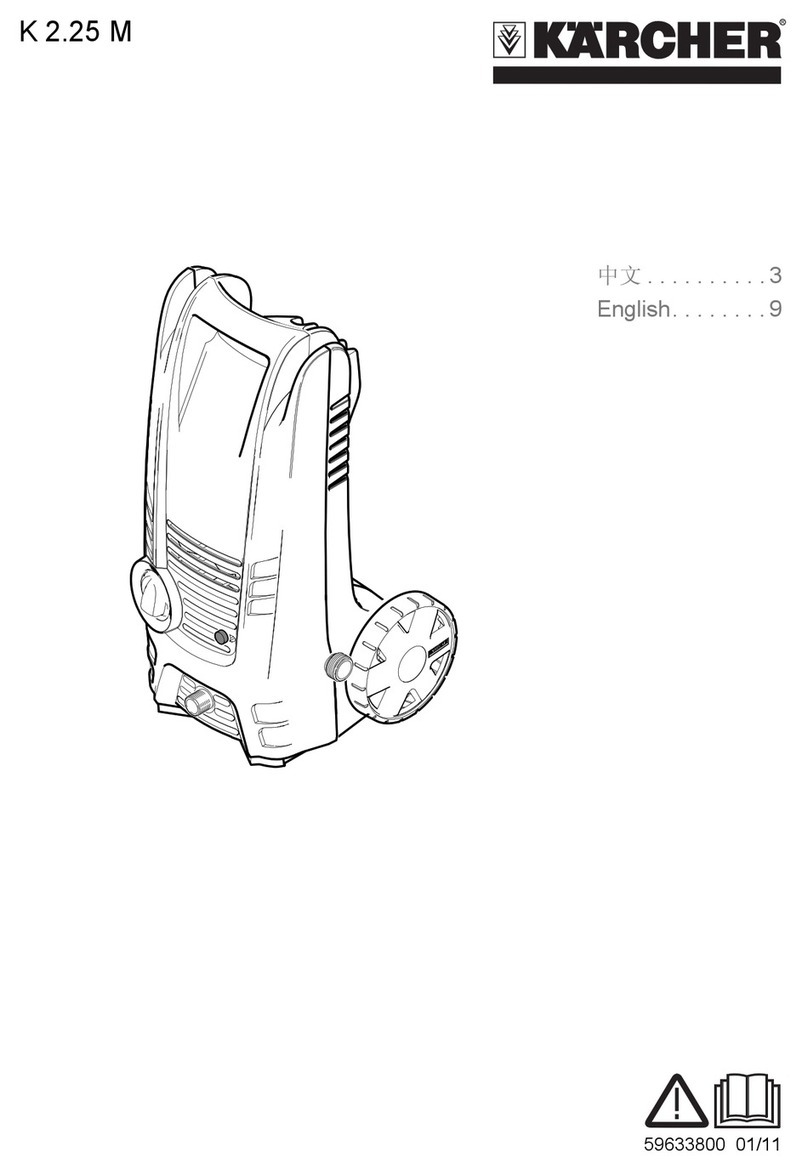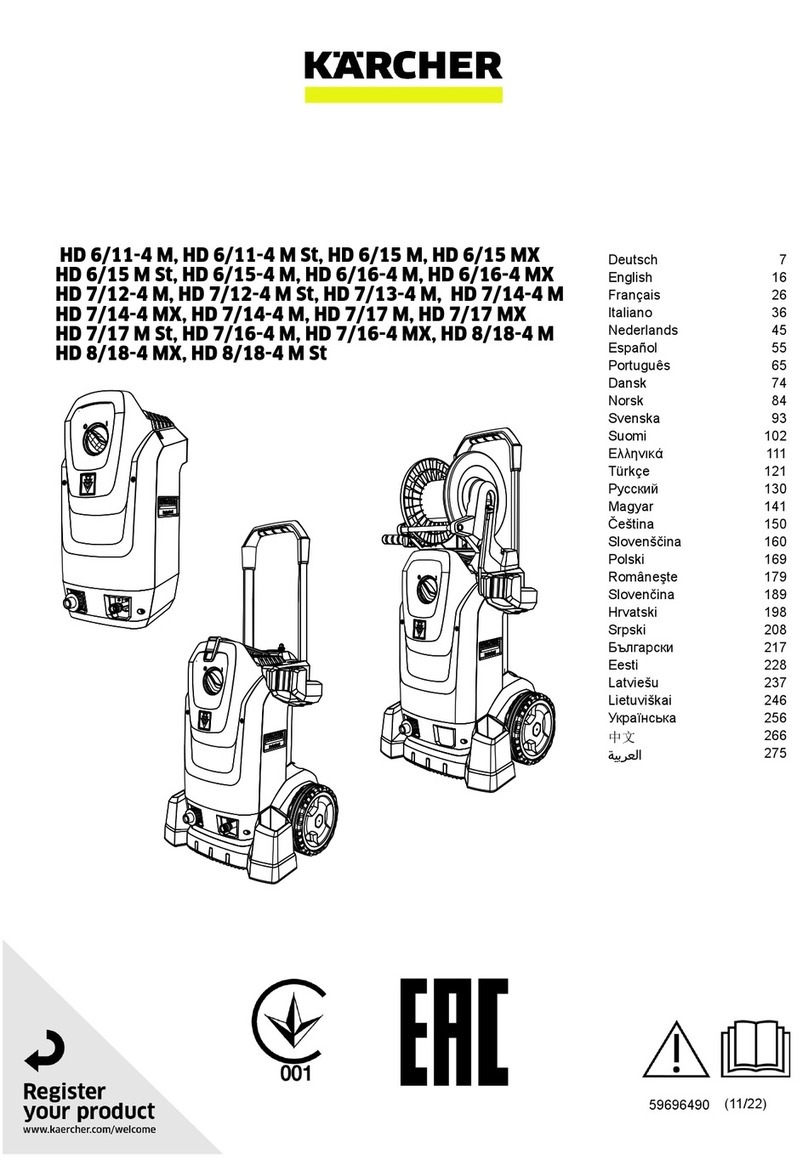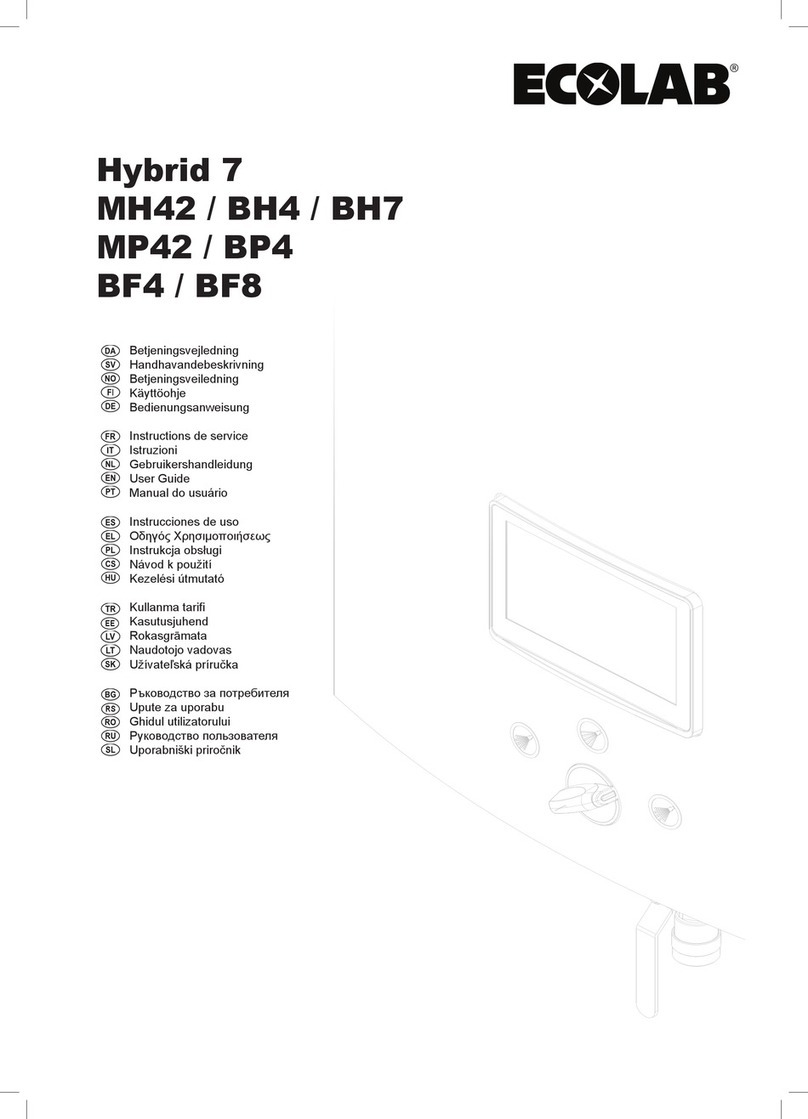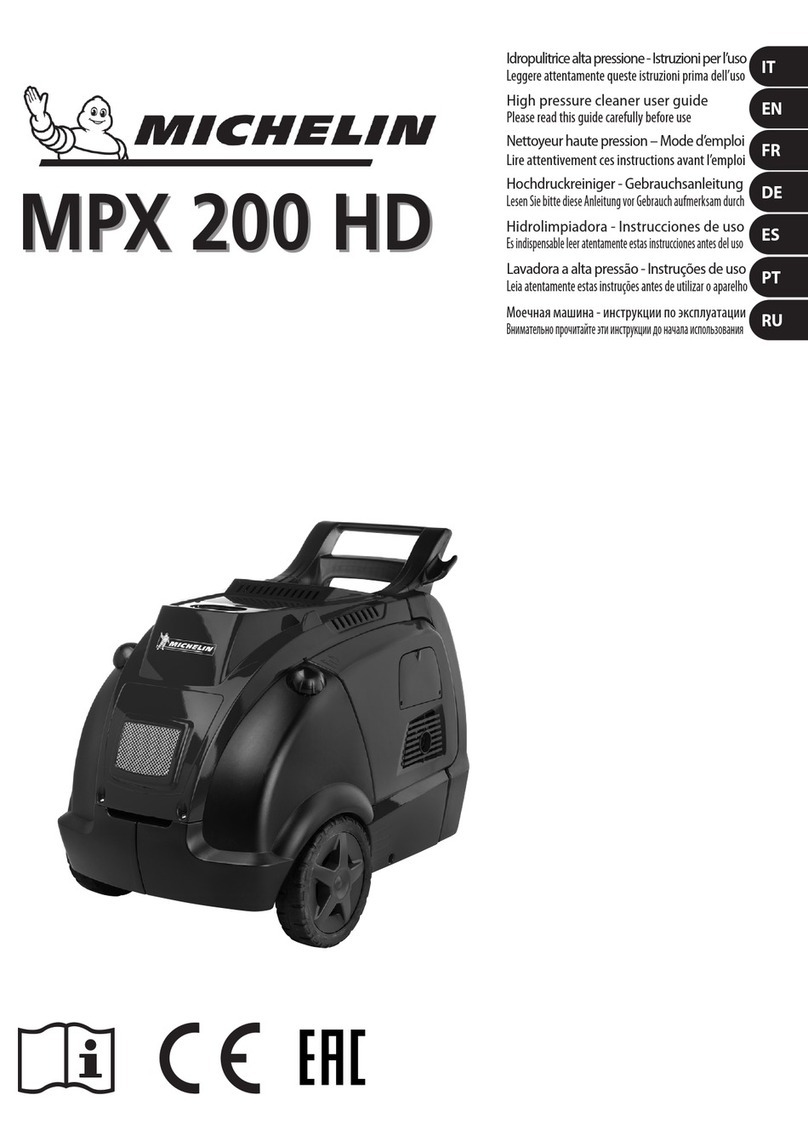Pressure Wave PWH2500 User manual

Part No. A12496 Rev. 0 5/25/05
IMPORTANT
Please make certain that the
person who is to use this
equipment carefully reads and
understands these instructions
before operating.
Table of Contents
Safety Guidelines/Definitions .................2
Consumer Saftey Information ................2
Important Safety Instructions ..............2-5
Carton Contents ......................................6
Assembly Instructions .............................7
Operating Instructions ...................... 8-12
Maintenance ..........................................13
Storage ..................................................14
Trouble Shooting Guide .................. 15-16
Warranty ................................................18
Español ............................................ 19-36
Français ........................................... 37-56
Record All Information and attach sales
receipt here for future reference:
Purchase Date:_______________________
Serial #: _____________________________
Operation Manual
for model PWH2500
Pressure Washer
Do Not return this product to the
retailer! Questions? 1-800-888-2468
Learn more about your pressure
washer, get answers to frequently
asked questions, and register on
line at www.devap.com

2- ENG
A12496
IMPORTANT SAFETY INSTRUCTIONS
Do not operate this unit until you have read and understand this
Operators Manual and the Engine Owners Manual for Safety,
Operation, and Maintenance Instructions.
RISK OF EXPLOSION OR FIRE
WHAT CAN HAPPEN HOW TO PREVENT IT
• Spilled gasoline and it’s vapors can
become ignited from cigarette sparks,
electrical arcing, exhaust gases, and hot
engine components such as the muffler.
• Shut off engine and allow it to cool before
adding fuel to the tank.
• Use care in filling tank to avoid spilling fuel.
Move pressure washer away from fueling
area before starting engine.
• Heat will expand fuel in the tank which
could result in spillage and possible fire
explosion.
• Keep maximum fuel level ½" below top of
tank to allow for expansion.
• Operating the pressure washer in an ex-
plosive environment could result in a fire. • Operate and fuel equipment in well venti-
lated areas free from obstructions. Equip
areas with fire extinguisher suitable for
gasoline fires.
READ AND SAVE THESE INSTRUCTIONS
This product may not be equipped with a spark arresting muffler.
If the product is not equipped and will be used around flammable
materials, or on land covered with materials such as agricultural crops, forest, brush,
grass, or other similar items, then an approved spark arrester must be installed and
is legally required in the state of California. It is a violation of California statutes
section 130050 and/or sections 4442 and 4443 of the California Public Resources
Code, unless the engine is equipped with a spark arrester, as defined in section 4442,
and maintained in effective working order. Spark arresters are also required on some
U.S. Forest Service land and may also be legally required under other statutes and
ordinances.
Engine exhaust contains chemicals known, in certain quantities, to
cause cancer, birth defects or other reproductive harm.
CONSUMER SAFETY INFORMATION
SAFETY GUIDELINES - DEFINITIONS
Indicates an imminently
hazardous situation
which, if not avoided, will result in death
or serious injury.
Indicates a potentially
hazardous situation
which, if not avoided, could result in death
or serious injury.
Indicates a potentially
hazardous situation
which, if not avoided, may result in minor
or moderate injury.
Used without the safety
alert symbol indicates a
potentially hazardous situation which, if not
avoided, may result in property damage.
This manual contains information that is important for you to know and understand.
This information relates to protecting YOUR SAFETY and PREVENTING EQUIPMENT
PROBLEMS. To help you recognize this information, we use the symbols below. Please
read the manual and pay attention to these symbols.
HAZARD

3- ENG A12496
• Materials placed against or near the
pressure washer can interfere with its proper
ventilation features causing overheating and
possible ignition of the materials.
• Never operate pressure washer in an area
containing dry brush or weeds.
• Muffler exhaust heat can damage painted
surfaces, melt any material sensitive to
heat (such as siding, plastic, rubber, or
vinyl), and damage live plants.
• Always keep pressure washer a minimum of
four feet away from surfaces (such as houses,
automobiles, or live plants) that could be
damaged from muffler exhaust heat.
• Improperly stored fuel could lead to
accidental ignition. Fuel improperly
secured could get into the hands of
children or other unqualified persons.
• Store fuel in an OSHA approved container,
in a secure location away from work area.
• Use of acids, toxic or corrosive chemicals,
poisons, insecticides, or any kind of
flammable solvent with this product could
result in serious injury or death.
• Do not spray flammable liquids.
• Breathing exhaust fumes will cause
serious injury or death! Engine exhaust
contains carbon monoxide, an odorless
and deadly gas.
• Operate pressure washer in a well
ventilated area. Avoid enclosed areas such
as garages, basements, etc.
• Never operate unit in a location occupied
by humans or animals.
• Some cleaning fluids contain substances
which could cause injury to skin, eyes, or
lungs.
• Use only cleaning fluids specifically recom-
mended for high pressure washers. Follow
manufacturers recommendations. Do not
use chlorine bleach or any other corrosive
compound.
RISK TO BREATHING
WHAT CAN HAPPEN HOW TO PREVENT IT
RISK OF EXPLOSION OR FIRE (continued)
HAZARD
WHAT CAN HAPPEN HOW TO PREVENT IT
• Your washer operates at fluid pressures
and velocities high enough to penetrate
human and animal flesh, which could
result in amputation or other serious injury.
Leaks caused by loose fittings or worn
or damaged hoses can result in injection
injuries. DO NOT TREAT FLUID INJECTION
AS A SIMPLE CUT! See a physician
immediately!
• Never place hands in front of nozzle.
• Direct spray away from self and others.
• Make sure hose and fittings are tightened
and in good condition. Never hold onto the
hose or fittings during operation.
• Do not allow hose to contact muffler.
• Never attach or remove wand or hose
fittings while system is pressurized.
RISK TO FLUID INJECTION
HAZARD
WHAT CAN HAPPEN HOW TO PREVENT IT
• Injuries can result if system pressure is not
reduced before attempting maintenance or
disassembly.
• To relieve system pressure, shut off
engine, turn off water supply, and pull gun
trigger until water stops flowing.
• Use only hoses and accessories rated
for pressure higher than your pressure
washer's PSI.
HAZARD

4- ENG
A12496
• Contact with hot surfaces, such as
engines exhaust components, could
result in serious burn.
• During operation, touch only the control
surfaces of the pressure washer. Keep
children away from the pressure washer
at all times. They may not be able to
recognize the hazards of this product.
• Spray directed at electrical outlets or
switches, or objects connected to an
electrical circuit, could result in a fatal
electrical shock.
• Unplug any electrically operated product
before attempting to clean it. Direct spray
away from electric outlets and switches.
RISK OF
ELECTRICAL SHOCK
HAZARD
WHAT CAN HAPPEN HOW TO PREVENT IT
RISK OF
ELECTRICAL SHOCK
RISK OF
ELECTRICAL SHOCK
RISK OF HOT
SURFACES
HAZARD
WHAT CAN HAPPEN HOW TO PREVENT IT
• Do not use acids, gasoline, kerosene,
or any other flammable materials in this
product. Use only household detergents,
cleaners and degreasers recommended
for use in pressure washers.
• Wear protective clothing to protect eyes
and skin from contact with sprayed
materials.
• Use of acids, toxic or corrosive chemicals,
poisons, insecticides, or any kind of
flammable solvent with this product could
result in serious injury or death.
RISK OF
CHEMICAL
BURN
HAZARD
WHAT CAN HAPPEN HOW TO PREVENT IT
• Fuel or oil can leak or spill and could
result in fire or breathing hazard, serious
injury or death can result. Fuel or oil
leaks will damage carpet, paint or other
surfaces in vehicles or trailers.
• If pressure washer is equipped with a
fuel shut-off valve, turn the valve to the
off position before transporting to avoid
fuel leaks. If pressure washer is not
equipped with a fuel shut-off valve, drain
the fuel from tank before transporting.
Only transport fuel in an OSHA approved
container. Always place pressure washer
on a protective mat when transporting to
protect against damage to vehicle from
leaks. Remove pressure washer from
vehicle immediately upon arrival at your
destination.
RISK OF INJURY OR PROPERTY DAMAGE
WHEN TRANSPORTING OR STORING
HAZARD
WHAT CAN HAPPEN HOW TO PREVENT IT

5- ENG A12496
• Reactive force of spray will cause gun/
wand to kickback, and could cause the op-
erator to slip or fall, or misdirect the spray.
Improper control of gun/wand can result in
injuries to self and others.
• Do not overreach or stand on an unstable
support.
• Do not use pressure washer while
standing on a ladder.
• Grip gun/wand firmly with both hands.
Expect the gun to kickback when
triggered.
• If proper starting procedure is not
followed, engine can kickback causing
serious hand and arm injury.
• If engine does not start after two pulls,
squeeze trigger of gun to relieve pump
pressure. Pull starter cord slowly until
resistance is felt. Then pull cord rapidly
to avoid kickback and prevent hand or
arm injury.
• The spray gun/wand is a powerful clean-
ing tool that could look like a toy to a
child.
• Keep children away from the pressure
washer at all times.
RISK OF UNSAFE OPERATION
HAZARD
WHAT CAN HAPPEN HOW TO PREVENT IT
• Unsafe operation of your pressure washer
could lead to serious injury or death to
you or others.
• Do not use chlorine bleach or any other
corrosive compound.
• Become familiar with the operation and
controls of the pressure washer.
• Keep operating area clear of all persons,
pets, and obstacles.
• Do not operate the product when
fatigued or under the influence of alcohol
or drugs. Stay alert at all times.
• Never defeat the safety features of this
product.
• Do not operate machine with missing,
broken, or unauthorized parts.
• Never leave wand unattended while unit
is running.
RISK OF INJURY FROM SPRAY
HAZARD
WHAT CAN HAPPEN HOW TO PREVENT IT
• High velocity fluid spray can cause
objects to break, propelling particles at
high speed.
• Light or unsecured objects can become
hazardous projectiles.
• Always wear ANSI approved Z87 safety
glasses.Wear protective clothing to protect
against accidental spraying.
• Never point wand at, or spray people or
animals.
• Always secure trigger lock when wand
is not in service to prevent accidental
operation.
• Never permanently secure trigger in pull
back (open) position.

6- ENG
A12496
Handle
Bagged Parts
Engine Frame and
Wheel Assembly
High Pressure
Hose
Chemical
Hose
Engine
Oil
Spray Gun
Engine
Manual
Accessories Panel
Operation
Manual
CARTON CONTENTS
Grommet Kit
with Quick
Connect Nozzles
Quick Connect Spray Wand
Registration
card
Nozzle
Cleaning
Tool

7- ENG A12496
6. To Assemble Accessories
Panel
a. Remove top screws on
handle assembly.
b. Loosen bottom screws on
handle assembly.
c. Place grooves in accessories
panel assembly onto screws
and slide panel assembly
into place.
d. Place screws (removed
earlier) into the top holes and
secure accessories panel
assembly to handles. Do not
overtighten.
4. Connect wand to gun. Tighten
securely.
5. Attach high pressure hose to
gun. Tighten securely.
Loosen
Remove
ASSEMBLY INSTRUCTIONS
Screws
1. To Assemble Quick Connect
Grommets:
a. Squeeze grommet and place
into hole, fitting groove to
rim.
b. Push grommet into place.
c. Repeat steps until all
grommets are assembled.
2. To Assemble Quick Connect
Nozzles:
a. Remove
five
colored
quick
connect
nozzles
from
plastic bag
and insert
them into correct grommet.
NOTE: Nozzles are color
coded to match colored
nozzles on panel. 7. Add engine oil (supplied)
to engine. Refer to Engine
Owners Manual supplied by
engine manufacturer for correct
procedure.
NOTE: There will be a slight amount
of oil in the engine from factory
testing.
3. Place handle assembly onto
frame, depress the snap buttons,
and slide the handle assembly
onto the frame until snap buttons
snap into place.
NOTE: The pump on this unit is
maintenance free and requires no oil,
if there is a problem with the pump
contact an Authorized Service Center.

8- ENG
A12496
OPERATING INSTRUCTIONS
BASIC ELEMENTS OF A
PRESSURE WASHER
High Pressure Pump (located inside
the shroud): Increases the pressure
of the water supply.
Engine: Drives the high pressure
pump.
High Pressure Hose: Carries the
pressurized water from the pump to
the gun and spray wand.
Spray Gun: Connects with spray
wand to control water flow rate,
direction, and pressure.
Quick Connect Spray Wand: Allows
the user to quickly change out high-
pressure nozzles. See How To Use
Spray Wand instructions in this section.
Chemical Hose: Feeds cleaning
agents into the pump to mix with the
water. See How To Apply Chemicals/
Cleaning Solvents instructions in this
section.
Compare the illustrations with your unit to familiarize yourself with the location
of various controls and adjustments. Save this manual for future reference.
Engine
High
Pressure
Hose
Spray Gun
Quick
Connect
Spray Wand
High Pressure Pump
(located inside the shroud)
BASIC ELEMENTS OF AN
ENGINE
Refer to the engine manual for
location and operation of engine
controls.
Choke Control: Opens and closes
carburetor choke valve.
Starter Grip: Pulling starter grip
operates recoil starter to crank
engine.
Fuel Valve Lever: Opens/closes
connection between fuel tank and
carburetor.
Engine Switch: Enables and disables
ignition system.
PRESSURE WASHER
TERMINOLOGY
PSI: Pounds per Square Inch. The
unit of measure for water pressure.
Also used for air pressure, hydraulic
pressure, etc.
GPM: Gallons Per Minute. The unit of
measure for the flow rate of water.
Chemical
Hose

9- ENG A12496
READ AND UNDERSTAND ALL WARNINGS BEFORE STARTING UNIT
When using the high pressure setting, DO NOT allow the high
pressure spray to come in contact with unprotected skin, eyes,
or with any pets or animals. Serious injury can occur.
Your washer operates at fluid pressures and velocities high enough to penetrate
human and animal flesh, which could result in amputation or other serious injury.
Leaks caused by loose fittings or worn or damaged hoses can result in injection
injuries. DO NOT TREAT FLUID INJECTION AS A SIMPLE CUT! See a physician
immediately!
NEVER fill fuel tank when engine is running or hot. Do not
smoke when filling fuel tank.
NEVER fill fuel tank completely. Fill tank to 1/2" below bottom of filler neck
to provide space for fuel expansion. Wipe any fuel spillage from engine and
equipment before starting engine.
NEVER run engine indoors or in enclosed, poorly ventilated areas. Engine exhaust
contains carbon monoxide, an odorless and deadly gas.
DO NOT let hoses come in contact with very hot engine muffler during or
immediately after use of your pressure washer. Damage to hoses from contact with
hot engine surfaces will NOT be covered by warranty.
NEVER pull water supply hose to move pressure washer. This
could damage hose and/or pump inlet.
DO NOT use hot water, use cold water only.
NEVER turn water supply off while pressure washer engine is running or damage to
pump will result.
DO NOT stop spraying water for more than two minutes at a time. Pump operates
in bypass mode when spray gun trigger is not pressed. If pump is left in bypass
mode for more than two minutes internal components of the pump can be
damaged.
If you do not understand these precautions, please call 1-800-888-2468 to
speak to a service representative for further instructions.
PRESSURE WASHER
OPERATING FEATURES
PRESSURE ADJUSTMENTS
The pressure setting is preset at the
factory to achieve optimum pressure
and cleaning. If you need to lower the
pressure, it can be accomplished by
these methods.
1. Back away from the surface
to be cleaned. The further away
you are, the less the pressure will
be on the surface to be cleaned.
2. Change to the 40º nozzle -
(white) this nozzle delivers a less
powerful stream of water and a
wider spray pattern.
DO NOT attempt
to increase pump
pressure. A higher pressure setting
than the factory set pressure may
damage pump.
CU: Cleaning Units. GPM multiplied by
PSI. GPM x PSI = CU
Bypass Mode: Allows water to
re-circulate within pump when the gun
trigger is not pulled.
Allowing the unit to
run for more than
two minutes without the gun trigger
pulled could cause overheating and
damage to the pump.
Chemical Injection System: Mixes
cleaners or cleaning solvents with
the water to improve cleaning
effectiveness.
Water Supply: All pressure washers
must have a source of water. The
minimum requirements for a water
supply are 20 PSI and 5 gallons per
minute.

10- ENG
A12496
Risk of Flying
Object could cause
risk of serious injury. Ensure nozzle
is completely inserted in QC socket,
and QC snap ring is fully engaged
(forward) before squeezing gun
trigger.
Risk of injection or
injury to person.
Do not direct discharge stream
toward persons, unprotected
skin, eyes, or any pets or animals.
Serious injury can occur.
The high pressure spray from your pressure washer is
capable of causing damage to surfaces such as wood,
glass, automobile paint, auto striping and trim, and delicate objects such as
flowers and shrubs. Before spraying, check the item to be cleaned to assure
yourself that it is strong enough to resist damage from the force of the spray.
*
TO USE SPRAY WAND
The nozzles for the spray wand are
stored in nozzle holder on the panel
assembly. Colors on the panel identify
nozzle location and spray pattern. See
chart to choose the correct nozzle for
the job to be performed.
CHANGING NOZZLES ON SPRAY
WAND
Risk of Flying
Object could
cause risk of serious injury. DO
NOT attempt to change nozzles
while pressure washer is running.
Turn engine off before changing
nozzles.
1. Pull quick connect coupler back
and insert nozzle.
2. Release quick connect coupler
and twist nozzle to make sure it
is secure in coupler.
Nozzle Color Red Yellow White Black
Spray Pattern
0º 15º 40º low pressure
Uses
powerful
pinpoint for
very intense
cleaning
intense
cleaning of
small areas
covers wide
areas of
cleaning
applies
cleaning
solutions
Surfaces *
Metal or
concrete
DO NOT use
on wood
metal,
concrete, or
wood
metal,
concrete,
wood, or vinyl
metal,
concrete,
wood, or vinyl

11- ENG A12496
STARTING
Prior to starting, refer to your engine
manual for proper starting procedure.
1. In a well ventilated outdoor
area add fresh, high quality,
unleaded gasoline with a pump
octane rating of 86 or higher. Do
not overfill. Wipe up spilled fuel
before starting the engine. Refer
to Engine Owners Manual for
correct procedure.
2. Check engine oil level. See
Engine Owners Manual for correct
procedure. NOTE: There will
be a slight amount of oil in the
engine from factory testing.
3. Verify the filter
screen is in
water inlet of
pump. NOTE:
Cone side
faces out.
4. Connect water
source to pump inlet. NOTE:
Water source must provide a
minimum of 5 gallons per minute at
20 PSI.
5. Connect high pressure hose to
pump outlet.
6. If applying a chemical or
cleaning solution, see How
To Apply Chemicals/Cleaning
Solvents instructions in this
section.
Filter Screen
Water
Source
High
Pressure
Hose
Hook-up
HOW TO APPLY CHEMICALS
AND CLEANING SOLVENTS
Applying chemicals or cleaning
solvents is a low pressure operation.
NOTE: Use only soaps and chemicals
designed for pressure washer use. Do
not use bleach.
To Apply chemicals:
1. Press chemical
hose onto
barbed fitting
located near high
pressure hose
connection of
pump as shown.
2. Place other end of chemical
hose with filter on it into container
holding chemical/cleaning
solution. NOTE: For every 7
gallons of water pumped 1 gallon
of chemical/cleaning solution will
be used.
3. Install low pressure (black)
nozzle into quick connect fitting
of spray wand, see How To Use
Spray Wand paragraph in this
section.
4. After use of chemicals, place
chemical hose into container of
clean water and draw clean water
through chemical injection system
to rinse system thoroughly. If
chemicals remain in the pump
it could be damaged. Pumps
damaged due to chemicals will
not be covered under warranty.
NOTE: Chemicals and soaps will not
siphon when spray wand is in the high
pressure setting.
Barbed Fitting

12- ENG
A12496
SHUTTING DOWN
1. After each use, if you have
applied chemicals, place chemical
hose into container of clean water
and draw clean water through
chemical injection system to rinse
system thoroughly. NOTE: Failure
to do so could cause damage to
the pump.
2. Turn engine off. See Engine
Owner’s Manual. NOTE: NEVER
turn the water off with the engine
running.
3. Turn water source off.
4. Pull trigger on spray gun to
relieve any water pressure in hose
or spray gun.
5. See Storage section in this
manual for proper storage
procedures.
7. Turn water source on.
NOTE: Failure to do so could
cause damage to the pump.
8. Start engine. See Engine
Owners Manual for correct
procedure. NOTE: When engine
rope is pulled, pressure starts
building in the gun. If the engine
does not start after two pulls,
pull the gun trigger to relieve this
pressure.
9. Depress trigger on gun to
start water flow. NOTE: Stand
on a stable surface and grip
gun/spray wand firmly with both
hands. Expect the gun to kick
when triggered.
10. Release trigger to stop water
flow.
11. Adjust spray for the task being
performed by changing quick
connect nozzle. See How To Use
Spray Wand instructions in this
section.

13- ENG A12496
3. Disconnect the spray wand from
the gun.
4. Remove the high-pressure nozzle
from the spray wand. Remove
any obstructions with the nozzle
cleaning tool provided and
backflush with clean water.
5. Direct water supply into spray
wand to backflush loosened
particles for 30 seconds.
6. Reassemble the nozzle to the
wand.
7. Reconnect spray wand to gun
and turn on water supply.
8. Start pressure washer and place
spray wand into high pressure
setting to test.
MAINTENANCE
NOZZLE CLEANING
If the nozzle becomes clogged
with foreign materials, such as dirt,
excessive pressure may develop. If
the nozzle becomes partially clogged
or restricted, the pump pressure will
pulsate. Clean the nozzle immediately
using the nozzle kit supplied and the
following instructions:
1. Shut off the pressure washer and
turn off the water supply.
2. Pull trigger on gun handle to
relieve any water pressure.
When performing
maintenance, you
may be exposed to hot surfaces,
water pressure, or moving parts that
can cause serious injury or death!
Before performing any maintenance
or repair, disconnect spark plug
wire, let engine cool and release
all water pressure. The engine
contains flammable fuel. DO NOT
smoke or work near open flames
while performing maintenance.
To ensure efficient operation and
longer life of your pressure washer, a
routine maintenance schedule should
be prepared and followed. If the
pressure washer is used in unusual
conditions, such as high-temperatures
or dusty conditions, more frequent
maintenance checks will be required.
ENGINE
Consult the Engine Owners
Manual for the manufacturer's
recommendations for any and all
maintenance. Consult the Engine
Owners Manual for the manufactur-
er's recommendations for any and
all maintenance. NOTE: The frame is
equipped with an oil drain hole to help
make changing the engine oil easier.
PUMP
The pump on this unit is maintenance
free and requires no oil, if there is a
problem with the pump contact an
Authorized Service Center.
HOW TO CLEAN THE WATER
INLET FILTER
This screen filter should be checked
periodically and cleaned if necessary.
1. Remove filter
by grasping
end and
removing it
from water
inlet of pump
as shown.
2. Clean filter by flushing it with
water on both sides.
3. Re-insert filter into water inlet of
pump. NOTE: Cone side faces out.
NOTE: Do not operate pressure
washer without filter properly installed.
Filter Screen

14- ENG
A12496
1. Obtain a funnel, six ounces of *RV
antifreeze, and 16 - 36 inches of
garden hose with a male hose
connector attached to one end.
Use only RV
antifreeze. Any
other antifreeze is corrosive and
can damage pump.
2. Disconnect spark plug wire.
3. Connect length of garden hose to
water inlet of pump.
4. Add *RV antifreeze to hose as
shown.
STORAGE
ENGINE
Consult the Engine Owners Manual for
the manufacturer's recommendations
for storage.
5. Pull engine starter rope slowly
several times until antifreeze
comes out of high pressure hose
connection of pump.
6. Remove garden hose from water
inlet of pump.
7. Reconnect spark plug wire.
*Windshield washer fluid may also be
used
PUMP
The manufacturer recommends using
a pump protector/winterizer, such
as, when storing the unit for more
than 30 days and/or when freezing
temperatures are expected. If a pump
protector/winterizer is not available,
*RV antifreeze needs to be run through
the pump as outlined in the steps
below.
NOTE: Using a pump protector/winterizer
or *RV antifreeze is to provide proper
lubrication to the internal seals of the
pump regardless of temperature or
environment.
PRESSURE WASHER
1. Drain all water from high pressure
hose, coil it, and store it in cradle
of the pressure washer handle.
2. Drain all water from spray gun
and wand by holding spray gun in
a vertical position with nozzle end
pointing down and squeezing
trigger. Store in gun holder.
3. Store chemical hose so it is
protected from damage.

15- ENG A12496
TROUBLE SHOOTING GUIDE
PROBLEM
Engine will
not start (see
Engine Manual
for further
engine
troubleshooting)
No or low
pressure
(initial use)
CAUSE CORRECTION
No fuel. Add Fuel.
Pressure builds up after two pulls
on the recoil starter or after initial
use.
Squeeze gun trigger to relieve
pressure.
Spark plug wire not attached. Attach spark plug wire.
Spray wand not in high pressure. See How to Use Spray Wand
instructions in the Operation
Section.
Low water supply. Water supply must be at least 5
GPM @ 20 PSI.
Leak at high pressure hose fitting. Repair leak. Apply sealant tape
if necessary.
Nozzle obstructed. See Nozzle Cleaning instructions
in the Maintenance section.
Water filter screen clogged. Remove and clean filter.
Air in hose. Turn off the engine, then the
water source. Disconnect the
water source from the pump inlet
and turn the water source on
to remove all air from the hose.
When there is a steady stream
of water present, turn water
source off. Re-connect water
source to pump inlet and turn on
water source. Squeeze trigger to
remove remaining air
High pressure hose is too long. Use high pressure hose under
100 feet.
Choke lever in the “Choke”
position on a “hot” engine or an
engine that has been exposed to
thermal heat for a long period of
time.
Move choke to the “No Choke”
position.
Choke lever in the “Choke” position. Move choke to the “No Choke”
position.
Choke lever in the “No Choke”
position.
Move choke to the “Choke”
position.
Engine ON/OFF switch in OFF
position.
Place engine ON/OFF switch in
ON position.
Fuel valve closed Move the fuel valve lever to the
“Open” position.

16- ENG
A12496
Water
leaking at
pump
Water leaking
at gun/
spray wand
connection
No or low
pressure
(after period
of normal
use)
PROBLEM CAUSE CORRECTION
Spray wand not in low pressure. See How to Use Spray Wand
paragraph in the Operation
Section.
Chemical screen not in cleaning
solution.
Clean filter.
Chemical too thick. Dilute chemical. Chemical should
be the same consistency as water.
Pressure hose is too long Lengthen water supply hose
instead of high pressure hose.
Chemical build up in chemical
injector.
Have parts cleaned or replaced
by AWSC.
Worn seal or packing Have replaced by AWSC.
Worn or obstructed valves. Have replaced by AWSC.
Worn unloader piston. Have replaced by AWSC.
Check and replace.
Loose hose connection.
Loose connections.
Tighten.
Piston packings worn. Have replaced by AWSC.
Worn or broken o-rings. Have replaced by AWSC.
Pump head or tubes damaged
from freezing.
Have replaced by AWSC.
Will not draw
chemicals
Make sure end of chemical hose
is fully submerged into cleaning
solution.
Chemical filter clogged.
Worn or broken o-ring.
Tighten.
Nozzle obstructed. See Nozzle Cleaning paragraph in
the Maintenance section for the
correct procedure.
Pump
Pulsates

17- ENG A12496
NOTES

18- ENG
A12496
LIMITED WARRANTY
DeVilbiss Air Power Company warrants to the original purchaser who uses the product in a
consumer application (personal, residential or household usage) that all products covered under this
warranty are free from defects in material and workmanship for one year from the date of purchase.
All products covered by this limited warranty which are used in commercial applications (i.e., income
producing) are warranted to be free of defects in material and workmanship for 90 days from the date
of original purchase. Products covered under this warranty include air compressors, air tools, service
parts, pressure washers, and generators.
DeVilbiss Air Power Company will repair or replace, at DeVilbiss' option, products or components
which have failed within the warranty period. Service will be scheduled according to the normal work
flow and business hours at the service center location, and the availability of replacement parts. All
decisions of DeVilbiss Air Power Company with regard to this limited warranty shall be final.
This warranty gives you specific legal rights, and you may also have other rights which vary from state
to state.
RESPONSIBILITY OF ORIGINAL PURCHASER (initial User):
• To process a warranty claim on this product, DO NOT return it to the retailer. The product must be
evaluated by an Authorized Warranty Service Center. For the location of the nearest Authorized
Warranty Service Center call 1-800-888-2468, 24 hours a day, 7 days a week or visit our web site
@ devap.com.
• Retain original cash register sales receipt as proof of purchase for warranty work.
• Use reasonable care in the operation and maintenance of the product as described in the Owners
Manual(s).
• Deliver or ship the product to the nearest Authorized Warranty Service Center. Freight costs, if any,
must be paid by the purchaser.
• Air compressors with 60 and 80 gallon tanks will be inspected at the site of installation. Contact
the nearest Authorized Warranty Service Center that provides on-site service calls for service call
arrangements.
• If the purchaser does not receive satisfactory results from the Authorized Warranty Service Center,
the purchaser should contact DeVilbiss Air Power Company.
THIS WARRANTY DOES NOT COVER:
• Merchandise sold as reconditioned, used as rental equipment, or floor or display models.
• Merchandise that has become damaged or inoperative because of ordinary wear, misuse*, cold,
heat, rain, excessive humidity, freeze damage, use of improper chemicals, negligence, accident,
failure to operate the product in accordance with the instructions provided in the Owners Manual(s)
supplied with the product, improper maintenance, the use of accessories or attachments not
recommended by DeVilbiss Air Power Company, or unauthorized repair or alterations.
* An air compressor that pumps air more than the recommended duty cycle during a one hour
period may be considered misuse.
• Repair and transportation costs of merchandise determined not to be defective.
• Costs associated with assembly, required oil, adjustments or other installation and start-up costs.
• Expendable parts or accessories supplied with the product which are expected to become
inoperative or unuseable after a reasonable period of use, including but not limited to sanding disks
or pads, saw and shear blades, grinding stones, springs, chisels, nozzles, o-rings, air jets, washers
and similar accessories.
• Merchandise sold by DeVilbiss Air Power Company which has been manufactured by and identified
as the product of another company, such as gasoline engines. The product manufacturer's
warranty, if any, will apply.
• ANY INCIDENTAL, INDIRECT OR CONSEQUENTIAL LOSS, DAMAGE, OR EXPENSE THAT
MAY RESULT FROM ANY DEFECT, FAILURE OR MALFUNCTION OF THE PRODUCT IS
NOT COVERED BY THIS WARRANTY. Some states do not allow the exclusion or limitation of
incidental or consequential damages, so the above limitation or exclusion may not apply to you.
• IMPLIED WARRANTIES, INCLUDING THOSE OF MERCHANTABILITY OR FITNESS FOR
A PARTICULAR PURPOSE, ARE LIMITED TO ONE YEAR FROM THE DATE OF ORIGINAL
PURCHASE. Some states do not allow limitations on how long an implied warranty lasts, so the
above limitations may not apply to you.
213 Industrial Drive • Jackson, TN 38301-9615
Telephone: 1-800-888-2468
FAX: 1-800-888-9036

Pieza No. A12496 Rev. 0 5/25/05
IMPORTANTE
Asegúrese de que la persona que
va a usar esta herramienta lea
cuidadosamente y comprenda estas
instrucciones antes de utilizarla.
Contenido
Normas de seguridad/definiciones. . . . . . . .20
Información de seguridad para el
consumidor . . . . . . . . . . . . . . . . . . . . . . . . . .20
Instrucciones importantes de seguridad. . . . . .
. . . . . . . . . . . . . . . . . . . . . . . . . . . . . . . . . .20-23
Contenido de la caja . . . . . . . . . . . . . . . . . . .24
Instrucciones para armar. . . . . . . . . . . . . . . .25
Instrucciones de operación . . . . . . . . . . .26-30
Mantenimiento . . . . . . . . . . . . . . . . . . . . . . . .31
Almacenaje . . . . . . . . . . . . . . . . . . . . . . . . . . .32
Guía de diagnóstico de problemas . . . .33-34
Garantía . . . . . . . . . . . . . . . . . . . . . . . . . . . . .36
English . . . . . . . . . . . . . . . . . . . . . . . . . . . . 1-18
Français . . . . . . . . . . . . . . . . . . . . . . . . . .37-56
¡No devuelva esta unidad al
establecimiento donde la compró!
¿Consultas? 1-800-888-2468
Familiarícese con su lavadora a
presión, obtenga respuesta rápida a las
preguntas más frecuentes y regístrela en
línea en:
www.devap.com
Manual de operación
para el modelo PWH2500
Lavadora a presión
Registre toda la información y adhiera
el comprobante de compra aquí para
referencia futura.
Fecha de compra: ____________________
N° de serie: __________________________

20- SP
A12496
RIESGO
LEA Y CONSERVE ESTAS INSTRUCCIONES
INSTRUCCIONES IMPORTANTES DE SEGURIDAD
¿QUÉ PUEDE OCURRIR? ¿CÓMO PREVENIRLO?
No opere este equipo hasta haber leído y entendido las instrucciones
de seguridad, operación y mantenimiento en este Manual del Operador
y en el Manual del Propietario del Motor.
RIESGO DE EXPLOSIÓN O INCENDIO
• La gasolina derramada y sus emanaciones
pueden incendiarse con las chispas de
cigarrillos, arcos eléctricos, el escape de la
combustión y componentes calientes del
motor tales como el silenciador.
• El calor hará expandir el combustible dentro
del tanque haciendo que se derrame y pueda
causar una explosión e incendio.
• Hacer funcionar la lavadora a presión dentro
de un ambiente explosivo podría ocasionar
una explosión.
• Los materiales colocados contra o cerca de
la lavadora a presión, pueden interferir con
su ventilación, causando el recalentamiento
y posible encendido de los materiales.
• Apague el motor y permítale enfriarse antes
de agregar combustible al tanque.
• Ponga sumo cuidado al llenar el tanque y evite
derramar el combustible. Antes de poner el
motor en marcha, mueva la lavadora a presión
fuera del área donde se cargó de gasolina.
• Para permitir la expansión del combustible
sin que se derrame, mantenga el nivel
máximo 13 mm (1/2") por debajo de la boca
del tanque.
• Haga funcionar el equipo y agregue
combustible en áreas bien ventiladas y sin
obstrucciones. Equipe las zonas con extintores
apropiados para incendio de gasolina.
• Nunca haga funcionar la lavadora a presión
en un sector que contenga malezas o pasto
seco.
INFORMACIÓN DE SEGURIDAD PARA EL CONSUMIDOR
Esta unidad podría no estar equipada con un cortachispas en el
silenciador del escape. Si esta unidad se usa alrededor de materiales
inflamables o en suelo cubierto con materiales tales como productos agrícolas, forestales,
arbustos u otros similares, se debe instalar un corta chispas autorizado, y en el estado de
California es obligatorio por ley que esté provisto de corta chispas y mantenido en buen estado
de funcionamiento de acuerdo a las secciones 130050 y/o secciones 4442 y 4443 del Código
de Recursos Públicos Naturales. El cortachispas también se requiere en algunas jurisdicciones
del Servicio Forestal del Gobierno de los EE.UU. y también puede ser obligatororio por otros
estatutos y ordenanzas. Los gases que escapan de esta máquina contienen químicos, que
en ciertas cantidades, se conoce que causan cáncer, defectos de
nacimiento u otras lesiones al sistema reproductivo.
DEFINICIONES DE NORMAS DE SEGURIDAD
Indica una situación de
inminente riesgo, que si no
se evita, causará la muerte o lesiones serias.
Indica una situación
potencialmente
riesgosa, que si no se evita, podría causar la
muerte o lesiones serias.
Indica una situación
potencialmente
peligrosa, que si no se evita, podría causar
lesiones menores o moderadas.
Usado sin el símbolo de
seguridad de alerta indica
una situación potencialmente riesgosa la que, que si
no se evita, podría causar daños a la propiedad.
Este manual contiene importante información para que usted sepa y comprenda. Esta información se
relaciona con la protección de SU SEGURIDAD Y LA PREVENCIÓN DE PROBLEMAS AL EQUIPO.
Para ayudarlo a reconocer esa información, utilizamos los símbolos indicados más abajo. Sírvase
leer el manual y prestar atención a dichos símbolos.
Table of contents
Languages:
Other Pressure Wave Pressure Washer manuals

